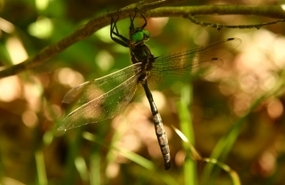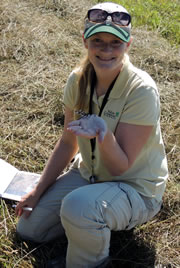Emerald in the rough

Hine's emerald dragonfly at Minesing Wetlands, ON (Photo by Chris Evans)
Deep in the heart of the Minesing Wetlands, southern Ontario’s third-largest wetland system, lives a mysterious creature. It is thought to inhabit only 50 distinct locations in the entire world, most of which are concentrated around the Great Lakes. In Canada, this mysterious species is found in the Minesing Wetlands and nowhere else.
If you listen closely, you might just hear a quiet “zzzzzip” overhead. If you’re lucky, you might catch the sunlight glinting off its emerald green eyes. And if you’ve got skills with a butterfly net, you might just get lucky enough to see this beautiful, delicate jewel close up. As you glimpse at its uniquely shaped claw-like appendages at the end of its tail, you'll know for sure that you have found a rare dragonfly gem (dragonflies should only be handled by those trained to do so).
Part of the emerald family, the Hine’s emerald dragonfly is large. It has quite particular habitat needs. Some people like having trees in their backyard and a nice garden. The Hine’s emerald needs sedges with intermittent trees, water with a high mineral content fed by groundwater and not surface water, which is near drier meadow and forest habitat. Oh, and don’t forget to add to the list the availability of holes burrowed in the ground by a particular species of crayfish, which the dragonfly can use to rest inside. The evolutionary real estate agent responsible for finding the home for this dragonfly in Ontario certainly had their work cut out for them. But now this special insect is happily at home in the fens of the Minesing Wetlands, which fulfills its laundry list of habitat requirements.
Even once that perfect home has been found, threats find their way into the dragonfly’s remote, lush and idyllic habitat. Pressures from nearby development, changes to hydrology that impact the flow of groundwater and the ongoing push of non-native invasive species into Ontario’s native wetland habitats can easily disrupt this sensitive dragonfly’s life cycle and its ability to successfully breed and thrive.
The Hine’s emerald is also extremely rare in the United States. It has been lost completely from wetlands it once inhabited. This is likely due in part to some of the factors mentioned above. However, the creation of critical habitat areas across the dragonfly’s range has shown some sign of helping populations stabilize. And for this globally rare, very particular, very tiny inhabitant of our big and busy planet, news like that is very good.
The Nature Conservancy of Canada (NCC) has worked in partnership with the Nottawasaga Valley Conservation Authority for nearly 45 years to protect rare and sensitive habitat in the Minesing Wetlands, located just 15 minutes west of Barrie, Ontario. The Hine’s emerald was just discovered in the wetlands in 2007 by local naturalist Chris Evans. The discovery helped conservation groups more sharply focus our efforts on where land should be acquired, and protected for the long term.
This year, NCC staff and external contractors made a huge effort to remove non-native phragmites from the perimeter of the Minesing Wetlands. This will prevent the spread of this nasty invader into the highly sensitive habitat occupied by the Hine’s emerald and the more than 1,000 other species using the Minesing Wetlands. It’s our wish that this green-eyed beauty continues to have a safe place to perch in a crayfish hole in the middle of one of the wettest and wildest places in southern Ontario. And we will all keep doing our best to keep it that way.
The Minesing Wetlands is supported by the Government of Canada through the Natural Areas Conservation Program, a unique public-private partnership to accelerate the pace of land conservation across southern Canada.


